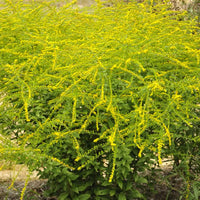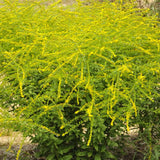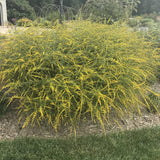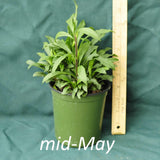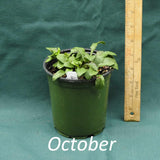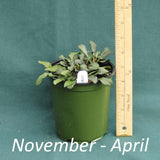But back to the fireworks goldenrod - it has a beautiful shape that is so pleasing to the eye - reminds me of unpruned forsythia in the way it wisps and curls. It’s very controlled and pollinators love it.
Here it is now:
You can see from the overwintered stalks how it grows. I need to finish clearing them.
You can also see if you look back to the fence, to the right, where I’ve cleared weeds and started transplanting some of the tall goldenrod. They’ll do well against the fence if only I can get them moved. Too many things to do, too few hours in the day!
More info (from one of our local native plant nurseries you can go to HERE ):
Fireworks Goldenrod is a well-behaved goldenrod that’s sure to allure pollinators into your garden when its starry golden flowers explode into bloom in early fall.
- Top-rated pollinator plant
- Easy to grow
- Covers ground and suppresses weeds
Details
- 3 to 4 ft. tall in flower
- Spreads to 3 to 4 ft. wide in 3 to 4 years
- The dark green foliage remains evergreen over the winter months
- Hardy in USDA hardiness zones 5, 6, 7, 8, and 9
Flowering period
It starts blooming in September and continues for three to four weeks.
How to grow
Best grown in full sun, but will still flower and look good with morning shade and afternoon sun. It can grow in just about any well-drained soil.
Care and maintenance
Old flowering stems can be cut to the ground level anytime during the winter. Plants will spread outward over time and can easily be dug up to replant elsewhere or share with friends.
Where to plant
In the middle of flower beds, where it will look attractive throughout the growing season and peak when it flowers in late summer.
When to plant
Spring and the fall are the best times, but Fireworks Goldenrod can be planted in the summer if attention is paid to keeping plants watered until they get established.
Spacing
2 to 3 feet apart when planting in a group.
When will my plant flower?
Plants purchased and planted before June will bloom their first year if planted in a well-prepared site and kept watered.
Native habitat and range
Old fields, at the edge of woodlands. Native throughout most of the eastern United States.
Source and origin
The original plant was rescued near Wilson, North Carolina by staff from NC Botanical Garden in the 1970s. It is now grown and appreciated around the world.


